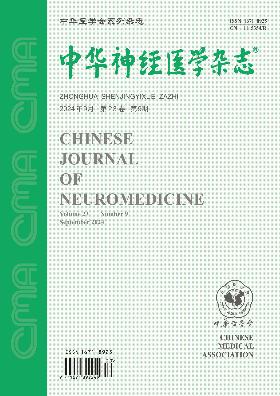Spinal cord stimulation and pulsed radiofrequency in treatment of herpes zoster neuralgia in the elderly
Q4 Medicine
引用次数: 0
Abstract
Objective To investigate the efficacies and differences of spinal cord stimulation (SCS) and pulsed radiofrequency (PRF) in the treatment of herpes zoster neuralgia in the elderly. Methods Sixty-three patients with herpes zoster neuralgia over 50 years old, admitted to our hospital from January 2018 to January 2019, were divided into SCS group (n=31) and PRF group (n=32) by prospective, randomized and controlled study. The stimulating electrodes were placed in epidural spinal ganglion segment for two weeks after percutaneous puncture in SCS group. In the PRF group, the radiofrequency needles were percutaneously punctured to the dorsal root ganglion under the guidance of X-ray. After the location of contrast medium was confirmed, each target was treated by pulsed radiofrequency for 360 seconds, followed by anti-inflammatory compound liquid injection. Numeric Rating Scale (NRS) scores, effective rate (percentage of patients having pain relief>50%) and complete relief rate (percentage of patients having NRS scores≤3) before, and one, 4, 12 and 24 weeks after operation of the patients from the two groups were recorded. Use of analgesics and calcium channel antagonists of the patients from the two groups were compared. Results NRS scores of patients from the two groups after operation were significantly lower than those before operation (P 0.05). The effective rates of pain treatment of patients from the two group reached to 56.67%-81.25%, and there was no significant difference between the two groups at each time point (P>0.05). The complete pain relief rate reached to 37%-71% in the two groups, and there was no significant difference between the two groups at each time point (P>0.05). Number of patients used analgesics and calcium channel antagonists before and after operation in the two groups showed significant differences (χ2=20.917, P=0.000; χ2=18.273, P=0.000), and number of patients used analgesics and calcium channel antagonists 4, 12 and 24 weeks after operation in the two groups was significantly smaller than that before operation (P 0.05). Conclusion SCS and PFR can effectively treat herpes zoster neuralgia and reduce the incidence of sequelae, without no significant difference in the clinical efficacy. Key words: Herpes zoster neuralgia; Spinal cord stimulation; Pulsed radiofrequency脊髓刺激和脉冲射频治疗老年人带状疱疹神经痛
目的探讨脊髓刺激(SCS)与脉冲射频(PRF)治疗老年人带状疱疹神经痛的疗效及差异。方法2018年1月~ 2019年1月我院收治的50岁以上带状疱疹神经痛患者63例,采用前瞻性、随机对照研究方法分为SCS组(n=31)和PRF组(n=32)。SCS组经皮穿刺后,在脊髓硬膜外神经节段放置刺激电极2周。PRF组在x线引导下经皮穿刺射频针至背根神经节。确认造影剂位置后,对每个靶标进行脉冲射频治疗360秒,然后注射抗炎复方液体。记录两组患者术前、术后1周、4周、12周、24周的NRS评分、有效率(疼痛缓解>50%的患者百分比)、完全缓解率(NRS评分≤3的患者百分比)。比较两组患者镇痛药及钙通道拮抗剂的使用情况。结果两组患者术后NRS评分均显著低于术前(P < 0.05)。两组患者疼痛治疗有效率为56.67% ~ 81.25%,两组各时间点差异无统计学意义(P>0.05)。两组疼痛完全缓解率为37% ~ 71%,两组各时间点疼痛完全缓解率比较差异无统计学意义(P>0.05)。两组患者术前术后使用镇痛药及钙通道拮抗剂的患者数量差异有统计学意义(χ2=20.917, P=0.000;χ2=18.273, P=0.000),两组术后4、12、24周使用镇痛药及钙通道拮抗剂的患者数量均显著少于术前(P < 0.05)。结论SCS与PFR均能有效治疗带状疱疹神经痛,减少后遗症的发生,临床疗效无显著差异。关键词:带状疱疹神经痛;脊髓刺激;脉冲射频
本文章由计算机程序翻译,如有差异,请以英文原文为准。
求助全文
约1分钟内获得全文
求助全文
来源期刊

中华神经医学杂志
Psychology-Neuropsychology and Physiological Psychology
CiteScore
0.30
自引率
0.00%
发文量
6272
期刊介绍:
 求助内容:
求助内容: 应助结果提醒方式:
应助结果提醒方式:


